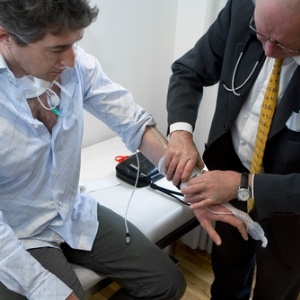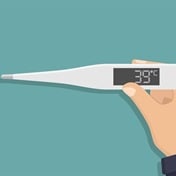
Polysomnography refers to the study of brain function during sleep. It is commonly associated with studies of altered breathing during sleep.
Normal Sleep
Sleep varies a lot depending on age, but basically one goes through 4-6 cycles of sleep per night. These cycles are made up of light sleep, then deep sleep and then REM sleep. As the night progresses, there tends to be more and more deep and REM sleep, which is why you are often in the middle of a dream when your alarm clock goes off. REM sleep is a peculiar state - you dream, but your brain makes your whole body go floppy, except for your eyes, which flicker back and forth (Rapid Eye Movements). As people get older, they need to sleep less and their sleep tends to be fragmented.
Reasons for polysomnography:
The reason is mostly to look for obstructive sleep apnoea (OSA). This is a condition where there is an obstruction at the back of the throat. The obstruction usually occurs when the back of the throat closes up as a result of the muscle tone in the palate and pharynx becoming weak, something which is often, but not always, associated with ageing. Very often overweight makes this worse and it is also frequently triggered by alcohol before bedtime. When moderately severe, the oxygen in the blood drops because of the blockage in the throat. When the oxygen level drops, the breathing muscles start to strain, which eventually leads to a brief gasp, associated with what is called an arousal (a split second of wakefulness).
The cycle then repeats itself: a drop in oxygen; gasping; arousal; cessation of breathing, drop in oxygen, etc., etc. This has a profound effect on normal sleep cycles. This means that the patient with OSA keeps on waking up to gasp for air, spending very little time in deep sleep and very little time in REM sleep. Essentially severe OSA means that one is woken up every minute all night long. This naturally leads to poor concentration and sleepiness and a host of other important medical conditions, including headache and high blood pressure.
Another condition for which polysomnography may be requested is narcolepsy. This is a condition where the normal control of REM sleep is lost. The result is that people with narcolepsy may feel very sleepy during the daytime; they may even experience dream fragments, as well as other aspects of REM sleep, such as sudden feelings of paralysis. Other sleep disturbances include periodic leg movements (when a leg kicks intermittently), and REM sleep behaviour disorder, during which patients can act out their dreams.
How is polysomnography done?
Polysomnography is done in a dedicated sleep laboratory. Patients will arrive in the laboratory in the early evening and be hooked up to a number of electrodes. Because the study lasts all night, the electrodes need to be held firmly in place and are therefore usually fixed with glue (which comes off with acetone). In obstructive sleep apnoea electrodes are placed around the eyes, under the chin and over the scalp to help determine the stage of sleep.
Bands are also usually placed around the chest and abdomen to monitor breathing and a small device to measure airflow is placed near the nose. Finally, an oxygen meter is attached to a finger or ear to monitor any drops in oxygen during the study. Once the study is under way, and if obstructive sleep apnoea is clearly present, a CPAP (continuous positive airway pressure) mask is placed over the face, and the pressure required to overcome the obstruction may then be recorded. Some laboratories prefer to do this separately and will book a second night to assess CPAP pressures. This is important to establish the correct pressure of the CPAP machine for when the patient goes home.




 Publications
Publications
 Partners
Partners















